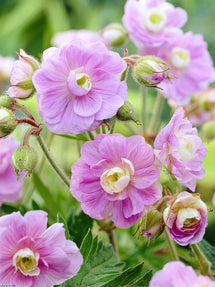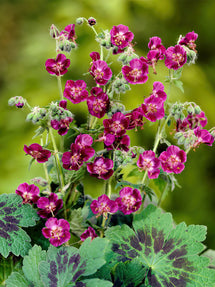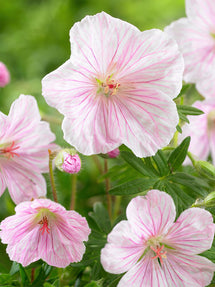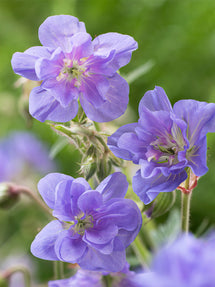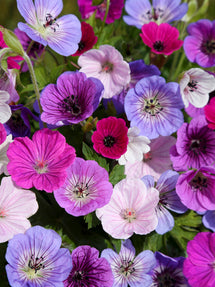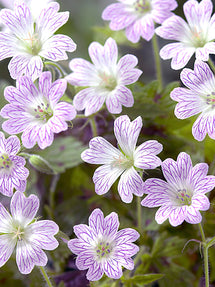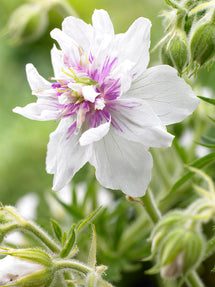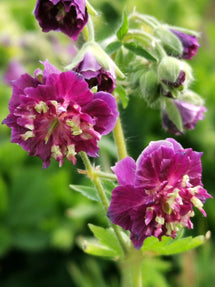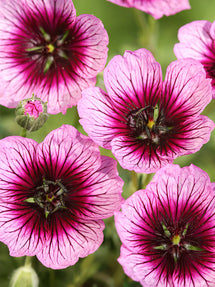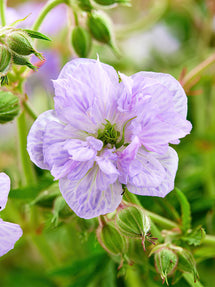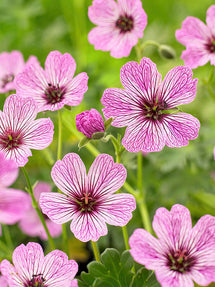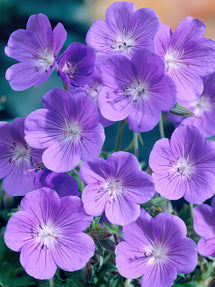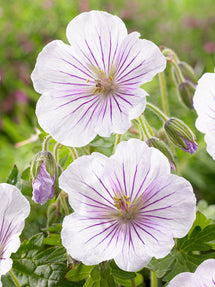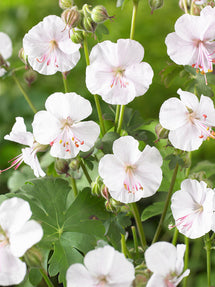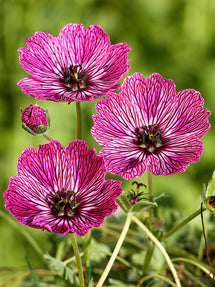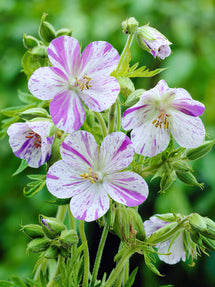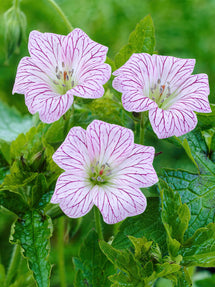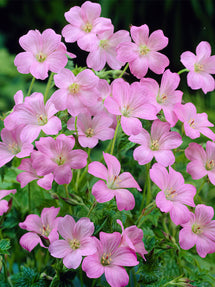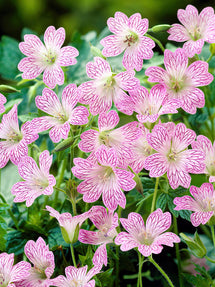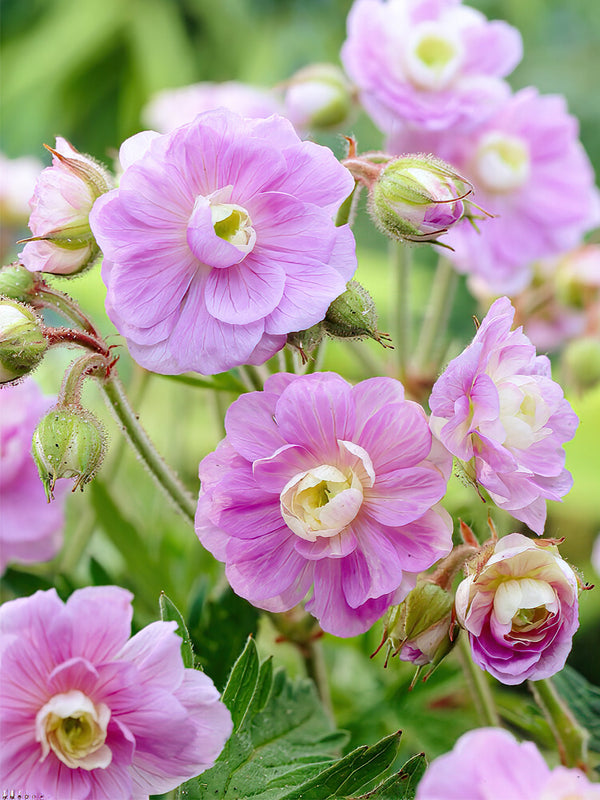Geraniums (Cranesbills)
Beautify Your Borders With The Simple Elegance Of Cranesbills
Renowned for their easygoing nature, stunning beauty, and incredible resilience, it is no surprise that Cranesbills (Geranium) are beloved by gardeners in the US. These long-lasting plants come in various elegant colors, making them an excellent choice for different garden settings, including borders, rock gardens, containers, and even as ground cover in woodland gardens. Whether you are just starting your journey or are an experienced gardener, Cranesbills are the perfect addition to your garden from late spring to late summer.
Discover DutchGrown’s top-quality Cranesbill bare roots and start planting.
Showing 1 - 19 in 19 items
Geraniums (Cranesbills)
Cranesbill: A Hardy Geranium With Surprising Characteristics
Cranesbills belong to the genus Geranium and are a group of (mostly hardy) perennial plants celebrated for their durability, ease of care, and delicate flowers. They typically produce an abundance of blooms with five petals, often detailed with delicate veining or distinct coloring, in delightful shades of pink, blue, purple, and white flowers. Depending on the variety, Geraniums grow from late spring to late summer, and even to early fall.
Beyond the flowers, the leaves of Geranium Cranesbills add significant appeal. Generally rounded and often lobed or deeply cut, the foliage provides texture and interest throughout the growing season. Some species boast attractive fall colors, and certain varieties have aromatic leaves.
Depending on the species, Cranesbills can be low-growing or taller. Some varieties make excellent ground covers, while others work well in borders or as specimen plants. Additionally, their nectar-rich flowers are valuable feeding stations for essential pollinators, such as bees and butterflies.
Charming Varieties That Bring Your Garden To Life
Cranesbill Geraniums come in a wide range of varieties, colors, and sizes. A few popular varieties include Geranium “Rozanne”, which is noted for its long blooming period and vibrant blue flowers. Another popular variety is Geranium “Sanguineum” (Bloody Cranesbill), which has bright pink to purple flowers that bloom in early summer. Geranium “Johnson's Blue” offers clear blue flowers. For bolder colors, Geranium “BullsEye Mix” adds pink or purple tones to beds and borders. Each variety brings something unique and dependable to your garden.
Their appeal goes beyond the flowers. Many Cranesbill varieties have pleasantly scented foliage that releases subtle hints of citrus, mint, or spice when touched. This small detail brings added depth to your garden experience.
How To Plant Cranesbills For Maximum Effect Outdoors
Planting Cranesbill Geraniums is simple, and they provide lasting beauty with very little upkeep. You can choose to plant the bare roots in borders, patio containers, or in temporary pots before planting them out later in the season. Follow the steps below to achieve the best results in your garden.
Start in the spring, once the last frost has passed. Choose a sunny spot, though it also tolerates partial shade (partial sun). Use well-draining soil that is enriched with some organic matter. When using containers or pots, make sure they have drainage holes.
Next, soak the roots in water for 3 to 6 hours to improve their moisture absorption. Dig holes and place the roots in the dry soil. Ensure that the crown is just below the surface and the top is above the soil level. Space the bare roots 7 to 11 inches apart to allow for proper airflow and prevent overcrowding. After planting, cover with soil and water thoroughly to settle the soil around the roots. Keep the soil hydrated in the first growing season.
Once established, these plants require minimal care and are often drought-tolerant. Here are some aftercare tips:
- Deadheading can encourage reblooming and prevent self-seeding. However, some gardeners allow the plants to self-seed for a more natural look.
- Dividing the plants every few years can rejuvenate them and prevents overcrowding.
- Cut the stems back in midsummer after flowering to encourage a second bloom in late summer.
- Some varieties are tender and may require protection or winter mulching in colder regions.
With just a little care, these perennials will thrive for seasons to come. Do you need more help? Follow the maintenance tips in our growing guide “How to Grow Geraniums”.
Explore A Wide Range Of Delicate Cranesbill For Sale At DutchGrown
Are you ready to grow Cranesbill in your garden? DutchGrown is an excellent source for your favorite varieties. With a wide variety of colors and forms, you’ll find something to suit every part of your garden, from borders to containers. Choose from the joyful Geranium “Splish Splash” or the unique Geranium “Phaeum Joseph Green”. Each type is carefully selected to provide you with top-quality bare roots. Discover our Cranesbill collection and grow with us. We ship throughout the US.
Frequently Asked Questions About Cranesbills
Do Cranesbills Like Sun Or Shade?
Cranesbill Geraniums grow best in full sun, where they produce the most blooms and maintain a compact shape. They can tolerate partial shade, but too much may reduce flowering and cause leggy growth. Cranesbill Geraniums are suitable for USDA zones 4 to 8.
What Is The Difference Between Geranium And Cranesbill?
Cranesbills are a group of hardy perennials in the Geranium genus. They're not the same as annual Geraniums, which belong to Pelargonium. True Geraniums, or Cranesbills, are known for their vigor, resilience, and long blooming season. They have a softer, more natural look, with finely cut foliage.
Does Cranesbill Geranium Spread?
Like other plants, Cranesbill Geraniums, can spread over time. Many varieties form large clumps, and some may self-seed if spent blooms aren’t removed. This makes them ideal for filling gaps or achieving a natural look in borders. To keep them healthy and under control, it's a good idea to divide them every few years. Deadheading can also help control unwanted spreading and encourage more blooms.
Is Cranesbill Geranium Invasive?
Cranesbill Geraniums, such as the wild Geranium, are not considered invasive in most gardens. They spread moderately and can be easily managed with occasional deadheading or division. When planted and cared for properly, most hardy Cranesbills that are used in gardens are well-behaved perennials that won’t overtake your space.
